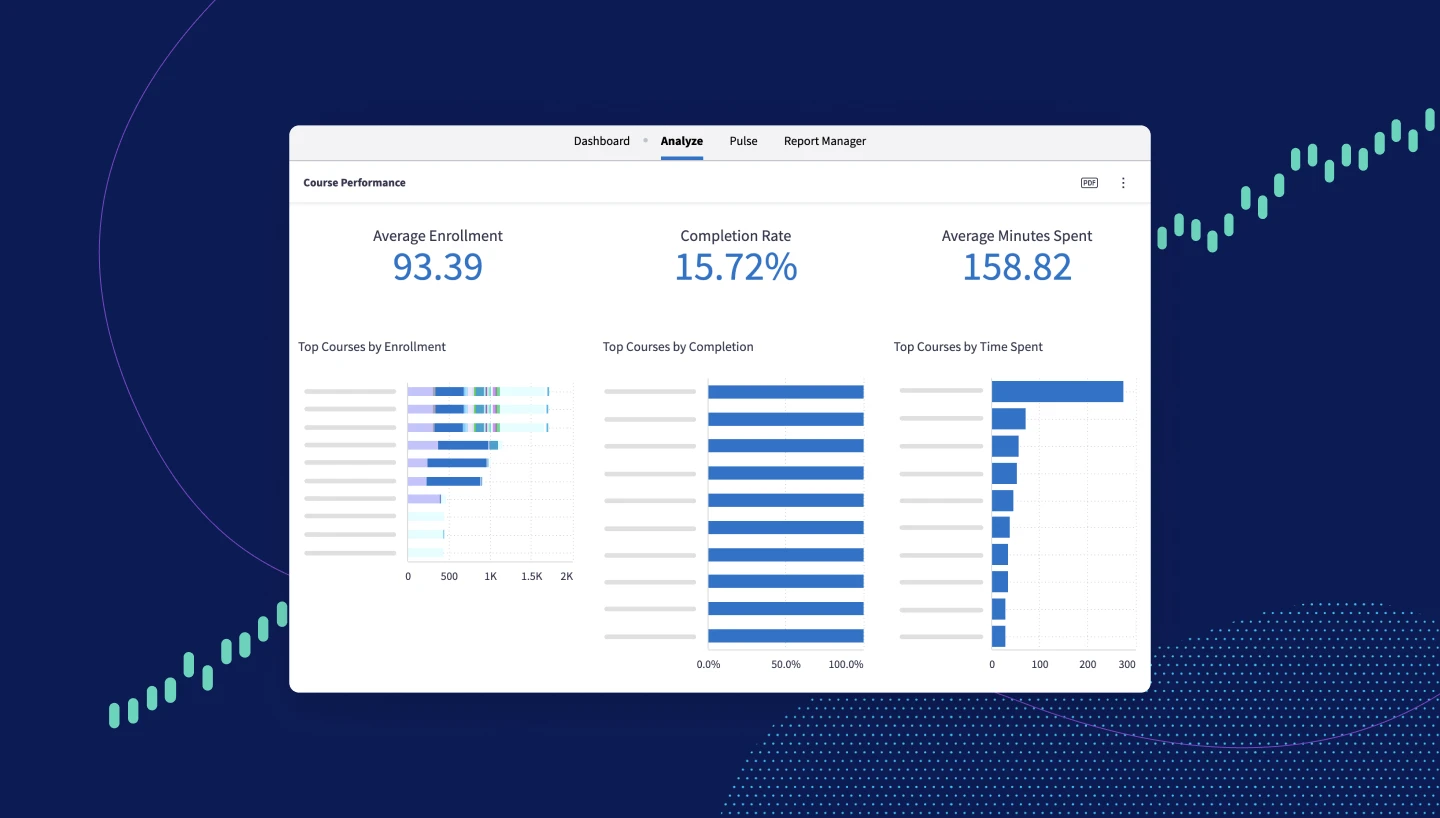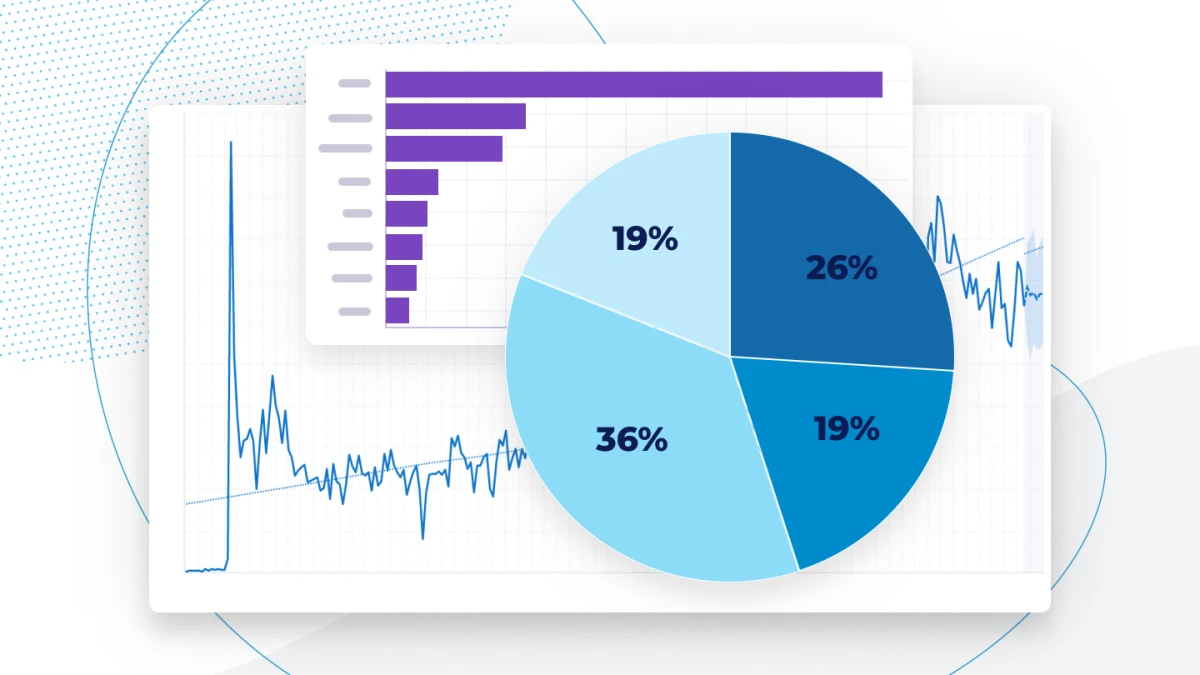Imagine spending months building the perfect training program only to hear crickets in response. You might wonder “Did my course actually help? Are my employees applying these skills? Does this training really matter?”
Although there isn’t a crystal ball to predict how your employee training will land, good data is a close second. Your reporting and analytics reveal what’s working, what’s not, and where to make tweaks. And with the right learning management system (LMS), extracting meaningful insights from your LMS reporting is straightforward.
In this blog, we’ll outline best practices for capturing learner analytics and explain how learning data can inform your company’s decisions. We’ll also explore how LMS reporting can put you on a path to long-term success. Our goal is to empower you with information that’ll help you create impactful training experiences for your employees, fostering a knowledgeable workforce that’s equipped to drive your organization's growth.
5 Best practices to collect and analyze employee training data
To fully benefit from the wealth of analytics and LMS reporting features available with today’s tech, it’s important to start with a solid learning plan. Consider adopting these best practices when capturing and analyzing data in your corporate learning initiatives:
- Establish clear metrics: What do you want to learn from your data? Identify the metrics that are most relevant to your organization's goals and objectives, ensuring you collect and analyze data that’s meaningful and actionable.
- Use built-in LMS reporting features: Most LMS offer robust tracking capabilities for training activities and online courses. Using these built-in features will allow you to automatically standardize your data collection. Some examples of Absorb’s customer-favorite reports include learner progress/ activity reports, course evaluations, and system usage.
- Regularly monitor and analyze data: Consistently review your data to identify trends, patterns, and insights. Regular data analysis will help you optimize your employee training programs and drive improvements in workforce performance.
- Collaborate with stakeholders: Communicate your findings and share insights with key stakeholders throughout your organization. Not only will this foster cross-functional collaboration but also guide L&D decision making.
- Iterate and improve: Use data to pinpoint areas where learners struggle and adjust training content, delivery methods, or provide additional support. Additionally, regularly evaluate your data collection and analysis practices, and refine them based on feedback and changing needs.
Read the blog: Unlocking insights: Tapping into LMS reporting & analytics
Using LMS reporting data to inform decision-making
With the right approach, LMS reporting data can be a game-changer in your decision-making, helping you personalize learning, identify what’s working, and pivot as needed. But to adopt a data-driven approach in employee training, you must start by using analytics and reporting insights. Here are some ways to use LMS reporting data when shaping your training strategies:
Identify areas for improvement
Use the data insights to pinpoint employee training areas that require enhancement. Doing this will help you allocate resources and focus efforts on the most impactful opportunities for improvement.
- Use case: For example, a sales team's LMS data reveals low completion rates for a product knowledge certification course. Further analysis shows high abandonment rates within a specific module on advanced features. Armed with this data, you could revamp the module with interactive elements, video demos, or microlearning snippets to boost engagement and knowledge retention.
Adapt training content
Analyzing learner engagement and progress data can highlight the need for adjustments to learning content in terms of delivery methods, skill level, or course materials.
- Use case: An LMS report shows that engineers struggle with problem-solving exercises in a technical skills course. Taking this training data into account, you could adjust the difficulty level of the exercises or offer tiered versions based on individual competency assessments.
Evaluate course effectiveness
Assessing course completion rates and learning outcomes can help you determine the effectiveness of individual courses, allowing you to make data-driven decisions.
- Use case: A compliance training course on data privacy has a high completion rate but low scores on the final assessment. Based on your learner’s performance, you could improve the assessment questions to ensure they accurately measure comprehension.
Align training with business goals
By understanding how your training initiatives are impacting workforce performance, you can better align your learning strategies with broader organizational goals.
- Use case: A marketing team's LMS data shows significant improvement in campaign performance metrics after completing a customer segmentation training program. As a result of this win, your L&D team could create more courses specific to business needs and challenges faced by different departments.

Future-proofing employee training through advanced LMS reporting
Integrating advanced analytics and reporting into employee training programs is crucial for organizations to stay ahead of the curve and capitalize on emerging opportunities. Here's how smart use of your data can set you up for long-term success:
- Identify skills gaps: Analyzing data from your LMS can help you identify emerging trends and skill gaps within your workforce. For instance, analyzing usage trends will help you see which courses are popular and identify emerging skill areas through search terms and course inquiries.
- Foster a high-performance culture: By adopting a data-driven approach to employee training, you can nurture a culture of improvement. For example, creating personalized learning opportunities encourages employees to explore resources beyond assigned courses, fostering a learning culture.
- Calculate ROI: Measure the return on investment for training programs based on productivity gains, improved performance, or reduced errors.
Drive corporate training success with LMS analytics and reporting
Above all, it’s important to remember that data isn’t just about numbers, it’s about people. By strategically collecting and analyzing LMS reporting data, you can move beyond guesswork and confidently create training programs that resonate with your employees and drive real results for your organization.
Ready to experience the power of advanced analytics and reporting in your employee training programs? Contact our team of experts today to learn more about Absorb LMS and how it can help you craft more effective, data-driven training strategies that fuel the growth and success of your organization.





